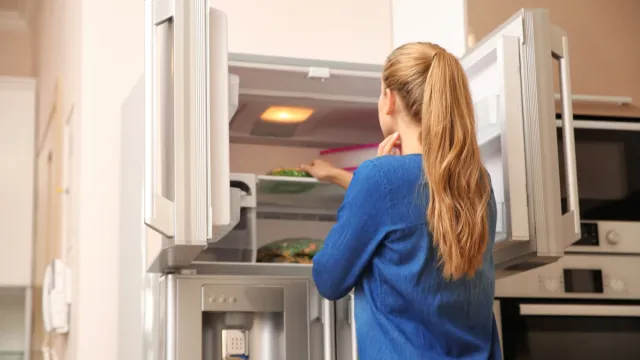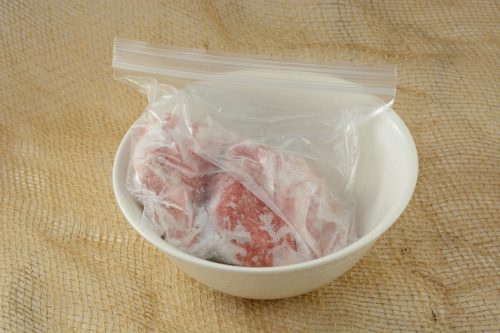Never Prepare Your Frozen Food This Way, CDC Warns
This common practice could be extremely risky when it comes to cooking what's in your freezer.

Frozen food is great way to whip up a quick meal when you're pressed for time. Whether you're throwing chicken strips over a salad or making a steak dinner, having something on hand in the freezer can be a game-changer on busy weeknights. The way you use your frozen food is, of course, totally up to you, but the Centers for Disease Control and Prevention (CDC) warns against making one very common mistake when preparing food from the freezer. To see what you should avoid when cooking frozen food, read on.
RELATED: Never Grill Your Meat or Chicken Like This, USDA Warns.
Never thaw frozen food on the counter.

While the kitchen countertop may seem like the most logical place to let your frozen food thaw, the CDC warns that "harmful germs can multiply very quickly at room temperature." The U.S. Department of Agriculture (USDA) also says food should never be thawed on the counter and should never be left at room temperature for more than two hours.
That's because, as the USDA explains, "bacteria grow most rapidly in the range of temperatures between 40°F and 140°F, doubling in number in as little as 20 minutes." As a result, that range of temperatures is often referred to as the "danger zone."
"Raw or cooked meat, poultry or egg products, as any perishable foods … are safe indefinitely while frozen," the USDA says. "However, as soon as they begin to thaw and become warmer than 40°F, bacteria that may have been present before freezing can begin to multiply."
RELATED: Never Put This on Your Meat After Barbecuing, CDC Warns.
You should also never thaw frozen food in hot water.

If you didn't plan ahead and you're rushing to thaw something quickly, you may try the old trick of placing your frozen food under hot water to speed up the process, but that can be dangerous, too.
The USDA says thawing your food this way is risky for the same reasons it's dangerous to leave it out on the counter. "Even though the center of the package may still be frozen… the outer layer of the food could be in the 'danger sone,'" explains the USDA.
It's better to skip thawing altogether than run your food under hot water.

If you're trying to whip up a meal in a hurry, it's safer to skip thawing altogether than to leave your frozen food in hot water or out on the counter.
According to the USDA, it's safe to cook frozen foods in their frozen state, although the agency warns that cooking will take about 50 percent longer than it would if you were cooking it after it was thawed.
RELATED: For more up-to-date information, sign up for our daily newsletter.
There are only three safe ways to thaw frozen food, the CDC and USDA say.

Both the CDC and USDA advise people to plan ahead when cooking frozen food. The USDA says the best way to safely thaw frozen food is in the refrigerator where it will stay at "a safe, constant temperature—at 40°F or below."
The agency says you can also thaw your food safely by using cold water. To use this method, the frozen food should be in a bag that's completely submerged, and you should change the water every 30 minutes. If you plan on trying this technique, make sure the bag doesn't leak because if it does, "bacteria from the air or surrounding environment could be introduced into the food," warns the USDA. Additionally, "the meat tissue may absorb water, resulting in a watery product."
The last option is to thaw your frozen food in the microwave. If you're going to go that route, you must cook it immediately after thawing. Otherwise, it may reach those dreaded "danger zone" temperatures.
RELATED: If You're Over 65, Don't Eat This One Kind of Meat Right Now, CDC Warns.





















